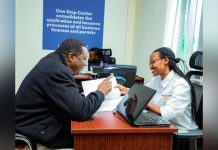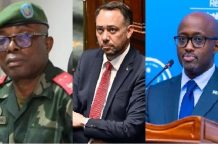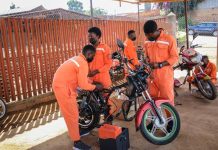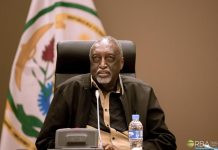Africa-Press – Rwanda. In January 2009, I was on my way to meet Gen Laurent Nkunda. Then, one good evening around 10pm at a news stand in Wandegeya, Kampala, I read a New Vision headline “Rwanda arrests Gen. Laurent Nkunda”. I had just traveled from Washington DC and was doing research on insecurity in the Great Lakes region.
A Congolese rwandophone had put me in contact with Nkunda’s assistant who was waiting for me in Kigali. The assistant was supposed to guide me to Masisi in North Kivu, the then stronghold of the National Congress for the Defence of the People (CNDP), the forerunner to the 23rd Movement (M-23).
Citing officials of both Rwanda and Congo, The New Vision reported that Nkunda had been arrested “after he resisted a joint Rwandan-Congolese military operation designed to pacify eastern Congo”. He has been under custody in Rwanda ever since.
I never got to interview Nkunda but I spoke to many senior officials of different groups in the DRC, in the army and the civil service, as well as UN officials of MONUC (renamed MONUSCO in 2010) officials. Anti-Rwanda hostility and related tensions were high as I approached different officials for interviews. The Bukavu border, for instance, was only open until 6 pm.
A question comes to mind immediately, given current circumstances: how come Rwanda arrested Gen Nkunda despite claims that it supported the CNDP, perhaps the most successful rebellion against Kinshasa at the time, which had seen large territories in North Kivu such as Masisi and Rutshuru fall to the insurgents.
A superficial reading of armed conflicts in the Congo, that focuses on that country’s minerals and how they fuel wars, fails to grasp why Rwanda got involved in that country to begin with, and appreciate its links to M-23 and CNDP before it.
Rwanda’s foray into the Congo was reluctant but necessary. It was the only way to avoid descending deeper into protracted conflict and genocide, both of which would have made the Central African Republic, and Somalia at its worst, seem stable.
In 1995 when the genocidal forces fled from Rwanda to the then Zaire (now DRC), they set out to reorganize and attack RPF-led Rwanda, with the diplomatic support of France. Humanitarian aid meant for Rwanda was being channeled across the border to the refugee camps under the control of the same genocidaires in eastern Congo. Zaire’s then President, Mobutu Sese Seko, who had positioned himself as a mentor to the then deceased President Juvenal Habyarimana of pre-genocide Rwanda, saw himself as the guarantor of the security of these Rwandans. He did not away shy from supplying them with weapons while also helping the French to channel ammunitions to them.
In Rwanda, the then Vice President and Minister of Defense, Gen Paul Kagame, pleaded with Mobutu to work together with the new government to disarm the genocidaires. The pleas fell on deaf ears. Both Mobutu – and the French political and military elite – believed the new government in Kigali could not possibly last long.
In interviews which I conducted with my colleague Frederick Golooba-Mutebi with two senior former commanders of the Habyarimana-era Forces Armees Rwandaises on separate occasions, Generals Paul Rwarakabije and Jerome Ngendahimana who had returned to Rwanda and were serving the new government, told us that they too were sure the new leadership would not last. They said they knew that the RPF would struggle to win over the people inside Rwanda because of the ideology they had consumed for long.
While in the jungles of Congo, they were sure that their reorganization and plans to invade Rwanda had support inside and outside the country. At the time, the most radical elements were still dominant in that insurgent. They believed that the biggest mistake they had made while still in charge in Rwanda was to have not finished “the job” of exterminating the Tutsi. A key part of their agenda once they recaptured power in Rwanda, was to start where they had stopped and complete the genocide.
Meanwhile, as he contemplated how to prevent the insurgents invading the country, Paul Kagame told the international community that if the camps in which they were hiding were not dismantled and their reorganization stopped, Rwanda would deploy and neutralize the security threat they posed by the genocidal forces. Mobutu believed Kagame was bluffing. However, people who know Kagame also know that bluffing does not count among his strengths.
In 1996, the Alliance of Democratic Forces for the Liberation of Congo emerged as a counterweight to Mobutu’s recalcitrance. Led by Joseph Desire Kabila and consisting of individuals and groups with various grievances against the Mobutu government, they spearhead the liberation of their country from Mobutu’s kleptocracy. Alongside them was the Rwandese Patriotic Army, on mission to dismantle the genocidaire-infested refugee camps and pursue the genocidal forces. Rwanda’s intervention had broad regional support. The then President of Tanzania, Julius Nyerere, and South Africa’s Nelson Mandela, told international media that African leaders had decided to arm Rwanda and help the post-genocide government fight against the genocidaires.
The alliance between Desire Kabila’s rebellion and Rwanda intersected at these shared interests: to overthrow a kleptocratic leadership and neutralize the genocidaires.
However, as it turned out Kabila was not any better than Mobutu. He quickly concentrated power around his Baluba ethnic group, as Mobutu had done with the people of Equateur. The excluded began to contemplate settling grievances around exclusion in military terms. Internal politics had forced Kabila to cut his alliance with Rwanda. As domestic grievances mounted, Kabila worked harder to prove his nationalist credentials through hostility against Rwanda.
In so doing he went a step too far. As Mobutu had done with Habyarimana’s Forces Armees Rwandaises (FAR), Kabila entered an alliance with the genocidal Forces Democratiques de la Liberation du Rwanda (FDLR). History was repeating itself. Rwanda pleaded with Kabila against this alliance while also trying to protect him against domestic political pressure. Kabila was between a rock and a hard place. He chose the alliance and told Rwanda to go to hell. For Rwanda, it was clear that any reorganisation of the FAR through FDLR meant that hell was not too far off.
Soon enough, the FDLR began to make incursions into Rwanda at night and withdrawing back into DRC during daytime. The objective was to make Rwanda ungovernable, including by making the people feel that the government lacked the capacity to protect them. As the war against the insurgency became protracted inside Rwanda, a force was deployed to the DRC to cut the insurgents’ supply routes and deny them a viable rear base.
In the process, the second Congo war that attracted at least six African armies began and ended through negotiations in 2002 when the invading countries agreed to withdraw their troops.
The war ended but the FDLR threat has remained. It has, from time to time, been resuscitated, whenever the authorities in Kinshasa have felt political pressure stemming from their internal shortcomings. The FDLR became and remains a useful tool for the political calculations of incumbent presidents in the DRC whenever elections are approaching.
The 2006 national elections divided the country in half: the West supported Jean Pierre Bemba and the East Joseph Kabila. Kabila was declared the winner amidst accusations of serious rigging. Kabila had much work to do to bring the West into his camp if he was to govern the country as a whole. Bemba refused to recognize Kabila as the winner, putting the latter’s credibility in Kinshasa and the entire western part of the country in serious doubt.
Kabila sought relief in his predecessors’ playbook. He revived the FDLR. With provincial tensions in high gear the gambit worked miracles. At the time, the leadership of the FDLR had withdrawn to minerals trading. Its members had largely integrated into local Congolese communities. With Kabila’s courting, however, they reorganized themselves into an active armed force.
In the run-up to the 2008 provincial elections, kinyarwanda-speaking communities (rwandophones) became targets as a strategy for political mobilization. Their participation in the political process was blocked, because they were considered to be people of doubtful nationality “nationalite douteuse.”
In much of the Kivus (north and south), they could vote but could not front candidates for election. The violence they were subjected to led to the emergence of Nkunda’s CNDP, which presented itself as a movement for “self-defense.”
Once again, a natural alliance between those facing exclusion in the DRC and a country preoccupied by existential threats emanating from the DRC, emerged.
To his credit, and unlike Mobutu, Joseph Kabila took the relationship between Nkunda’s armed group and Rwanda seriously. After a series of protracted negotiations, it was agreed that the armies of the two governments would work together to pacify the region in what was dubbed Operation Umoja Wetu I and II.
However, domestic pressure in Kinshasa forced Kabila to abandon this initiative, which had restored confidence and trust between the authorities of the two countries and their respective armies.
The aftermath of the 2011 elections in the DRC and the emergence of the M-23 follow this pattern: the collapse of domestic politics, hostility towards Congolese rwandophones, the revival of FDLR as a sure way to get Kigali interested.
The resultant diplomatic and military tensions are usually sufficient diversion for the authorities in Kinshasa to survive another election. Or they become the election itself, like it was with Mobutu who believed that all that Rwanda could do is bluff.
Rwanda perceives no active threat from Congo as long as the FDLR are demobilized.
Nkunda’s arrest was the result of his failure to keep up with changes in the context and his insistence on marching on to Kinshasa, even after the entirely practical alliance he had with Kigali had collapsed after the two governments decided to work together.
Herein lies the solution to the intermittent tensions: demobilize the FDLR for good, and respect the rights of Congo’s Kinyarwanda speakers whose only relationship with Rwanda is their language and cultural heritage.
Time is a great teacher. I now have the answers to many of the questions I would have asked Gen Nkunda had our meeting in Masisi taken place as planned in January 2009.
For More News And Analysis About Rwanda Follow Africa-Press






